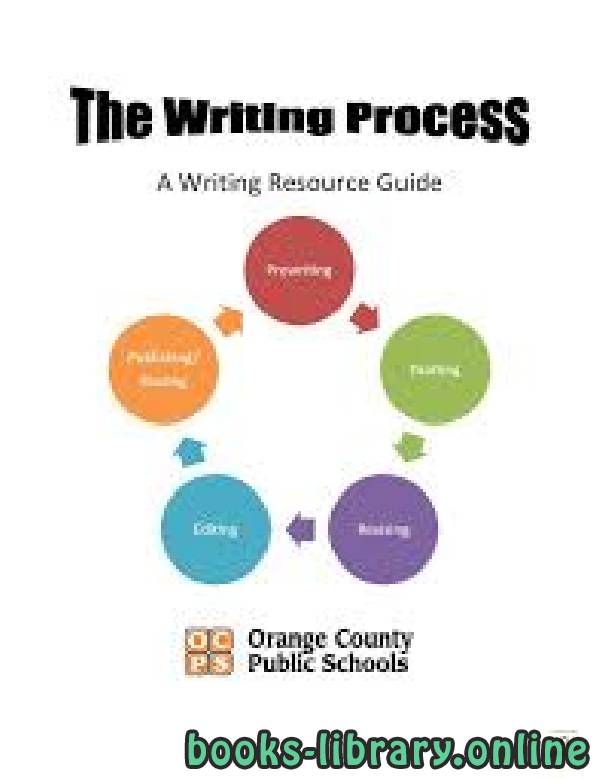📘 قراءة كتاب Process Writing أونلاين


هذا القسم يهتم بالكتابة باللغة الإنجليزية .
الكتابة تُمثّل لُغة نصية عبر استخدام رسومات رمزية (حروف)، ويمكن بها توثيق النطق ونقل الفكَر والأحداث إلى رموز يمكن قراءتها حسب نموذج مخصص لكل لغة. وبدأ الإنسان الكتابة عن طريق الرسم ثم تطورت هذه الرموز إلى أحرف لكي تختصر وقت الكتابة.
ولقد بدأ الإنسان الكتابة مستخدما الوسائل المتاحة لديه حيث بدأ باستخدام النقش على الحجر لتدوين ما يريده ثم انتقل إلى الكتابة على أوعية أخرى كالرق والبردي والورق الذي اخترع في بداية القرن الثاني الميلادي. ثم ما لبث الإنسان الأكثر تقدما أن اخترع الآلات التي تساعده على الكتابة مثل الآلات الكاتبة والمطابع، وأخيرا أصبح الإنسان يستخدم الكتابة من خلال أجهزة متقدمة مثل الحواسيب، وأصبح يتعامل اليوم بما يسمى الكتب الإلكترونية.
Writing is a medium of human communication that represents language with signs and symbols. For languages that utilize a writing system, inscriptions can complement spoken language by creating a durable version of speech that can be stored for future reference or transmitted across distance. Writing, in other words, is not a language, but a tool used to make languages readable.[1] Within a language system, writing relies on many of the same structures as speech, such as vocabulary, grammar, and semantics, with the added dependency of a system of signs or symbols. The result of the activity of writing is called a text, and the interpreter or activator of this text is called a reader.
H.G. Wells argued that writing has the ability to "put agreements, laws, commandments on record. It made the growth of states larger than the old city states possible. It made a continuous historical consciousness possible. The command of the priest or king and his seal could go far beyond his sight and voice and could survive his death".[3] As human societies emerged, collective motivations for the development of writing were driven by pragmatic exigencies like keeping history, maintaining culture, codifying knowledge through curricula and lists of texts deemed to contain foundational knowledge (e.g., The Canon of Medicine) or artistically exceptional (e.g., a literary canon), organizing and governing societies through the formation of legal systems, census records, contracts, deeds of ownership, taxation, trade agreements, treaties, and so on. For example, around the 4th millennium BC, the complexity of trade and administration in Mesopotamia outgrew human memory, and writing became a more dependable method of recording and presenting transactions in a permanent form.[4] In both ancient Egypt and Mesoamerica, on the other hand, writing may have evolved through calendric and political necessities for recording historical and environmental events.
Individual motivations for writing include improvised additional capacity for the limitations of human memory (e.g., to-do lists, recipes, reminders, logbooks, maps, the proper sequence for a complicated task or important ritual), dissemination of ideas (as in an essay, monograph, broadside, petition, or manifesto), imaginative narratives and other forms of storytelling, personal or business correspondence, and lifewriting (e.g., a diary or journal).
Contents
1 Writing systems
1.1 Logographies
1.2 Syllabaries
1.3 Alphabets
1.3.1 Abjads
1.3.2 Abugidas
1.4 Featural scripts
1.5 Historical significance of writing systems
1.6 Tools and materials
2 History
2.1 Mesopotamia
2.2 Egypt
2.3 Elamite scripts
2.3.1 Cretan and Greek scripts
2.4 China
2.5 Indus Valley
2.6 Central Asia
2.7 Phoenician writing system and descendants
2.8 Mesoamerica
2.9 South America
Process Writing
The acquisition of a language, whether our native tongue or a second language
presumes a process in which both receptive skills (listening and reading) and productive
skills (speaking and writing) intervene to affect and complement each other
simultaneously. It is through the integration of these four separate skills that learners’
language performance is comprehensively strengthened to attain the desired
communicative competence, in other words, the ability to communicate effectively,
both orally and in writing, to use language according to the parameters imposed by the
speech community in which they are inserted. According to Hyme (in Widdowson,
1989:132), who coined the term communicative competence, these parameters not only
involve the knowledge of composing sentences correctly according to grammatical rules
but also the possibility, feasibility and appropriateness of the utterance.
writing english
writing skills
writing paragraph
writing translation
writing a story
writing skills pdf
writing email
writing skill
definition of writing
سنة النشر : 2008م / 1429هـ .
حجم الكتاب عند التحميل : 0.7MB .
نوع الكتاب : pdf.
عداد القراءة:
اذا اعجبك الكتاب فضلاً اضغط على أعجبني و يمكنك تحميله من هنا:

شكرًا لمساهمتكم
شكراً لمساهمتكم معنا في الإرتقاء بمستوى المكتبة ، يمكنكم االتبليغ عن اخطاء او سوء اختيار للكتب وتصنيفها ومحتواها ، أو كتاب يُمنع نشره ، او محمي بحقوق طبع ونشر ، فضلاً قم بالتبليغ عن الكتاب المُخالف:
 قبل تحميل الكتاب ..
قبل تحميل الكتاب ..
يجب ان يتوفر لديكم برنامج تشغيل وقراءة ملفات pdf
يمكن تحميلة من هنا 'http://get.adobe.com/reader/'


 منصّة المكتبة
منصّة المكتبة 